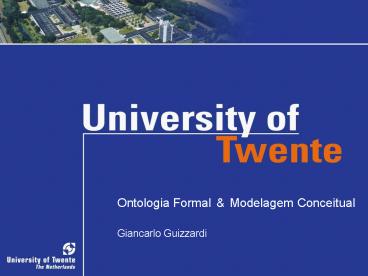Ontologia Formal - PowerPoint PPT Presentation
1 / 34
Title:
Ontologia Formal
Description:
UML is a standard visual notation for the purpose of specifying descriptive and ... Gerd Wagner, Eindhoven University of Technology, The Netherlands. Heinrich Herre, ... – PowerPoint PPT presentation
Number of Views:42
Avg rating:3.0/5.0
Title: Ontologia Formal
1
Ontologia Formal Modelagem Conceitual
Giancarlo Guizzardi
2
Conceptual Modeling
3
Unified Modeling Language
- UML is a standard visual notation for the purpose
of specifying descriptive and prescriptive models
of software systems
4
Formal Ontology and Conceptual Modeling
- Conceptual modeling should be founded on formal
upper-level ontologies, i.e., it a conceptual
modeling language should explicitly defined
ontological semantics
5
Formal Ontology and Conceptual Modeling
- Conceptual modeling should be founded on formal
upper-level ontologies, i.e., it a conceptual
modeling language should explicitly defined
ontological semantics
OntoUML
6
General Formal Ontology
Basic Ontological Relations Instantiation
,n Inherence i Holding h membership
? parthood lt,?,lte,ltu Framing f Containment
c Association a Location occ
Basic Ontological Categories Abstract Universals
Individuals Substance Moment Quality Relatio
nal Moments Situoid (process) Chronoid Topoid
7
Individuals
- Individuals They belong to the realm of concrete
entities, which means that they have necessarily
temporal and spatial qualities. - Individuals may be substances, moments,
chronoids, topoids, situoids (processes).
8
Substance
- A substance is that of which can exist by itself,
i.e., they are not existentially constantly
dependent on any other entity. - Every substance is found on matter
9
Moments
- It can only exist in another individual (e.g. a
charge in a conductor, the color of a fruit, a
purchase order, a flight connection) - There are one-place moments which are
existentially dependent on one substance
(Quality) - and relational moments which depend on a
multitude of substances - The inherence relation (i) glues moments to
substances
ED(x,y) ? ??(x) ? ?(?(x)??(y))
10
Relational Moments
- Distinction between formal and Material relations
- The relata Material relations are mediated by
individuals called relators. Ex a
flighconnection is a relator connecting airports
- h(c3427,Pisa,Paris)
- For every material relation, there is a relator
universal whose instances connect individuals
that share a relational moment
11
Universals
- Universals entities that can be instantiated
simultaneously by a multiplicity of different
individuals that are similar in given respects.
Time- and space-independent patterns of features
- The instantiation relation () is defined
between individuals and universals and a
higher-order instantiation relation (n) between
universals of different orders
12
Rigidity
- A Universal U is rigid (R) iff, every instance
of U is necessarily so. A Universal T is
anti-rigid (R) iff every instance of T is not
necessarily so. - Ex Person v.s. Student
RIGID(?) ? ?(??(x) ???(x)) ANTI-RIGID(?) ?
?(??(x) ????(x))
13
External Dependence
- An individual x is externally dependent on an
individual y iff, at any time that x exists, y
also exists Ex Hole/Host - A universal U is dependent (D) iff, for all its
instances, there exists something they are
externally dependent on.
DEP(?,?,R) ? ?(??(x) ??y?(y) ?R(x,y))
14
(No Transcript)
15
(No Transcript)
16
-RD
17
(No Transcript)
18
-R-D
19
(No Transcript)
20
(No Transcript)
21
(No Transcript)
22
Part-whole relations
- Primary characteristics
- non-reflexive, asymmetric, transitive, weak
supplementation - Secondary characteristics
- shareable, essential, inseparable, mandatory
23
(No Transcript)
24
Johns Brain
part-of
John
part-of
Knowledge Representation Group
25
Contextual Part-Whole relations
- x ltU y means x is a part of y in the context of
U - For every universal U, there universals U1Un,
such that xUi and yUi and every instance of
Ui is part of an instance of U
26
(No Transcript)
27
Person
28
(No Transcript)
29
John
part-of
Johns Brain
30
John
part-of
Johns Brain
?(?Person(x) ??!y Heart(y) ? partOf(y,x) ?(?Person
(x) ??!y Brain(y) ? ?partOf(y,x)
31
(No Transcript)
32
(No Transcript)
33
(No Transcript)
34
Agradecimentos
Gerd Wagner, Eindhoven University of Technology,
The Netherlands
- Nicola Guarino,
- ISTC-CNR,
- Trento, Italy
Heinrich Herre, GOL, University of Leipzig,
Germany































